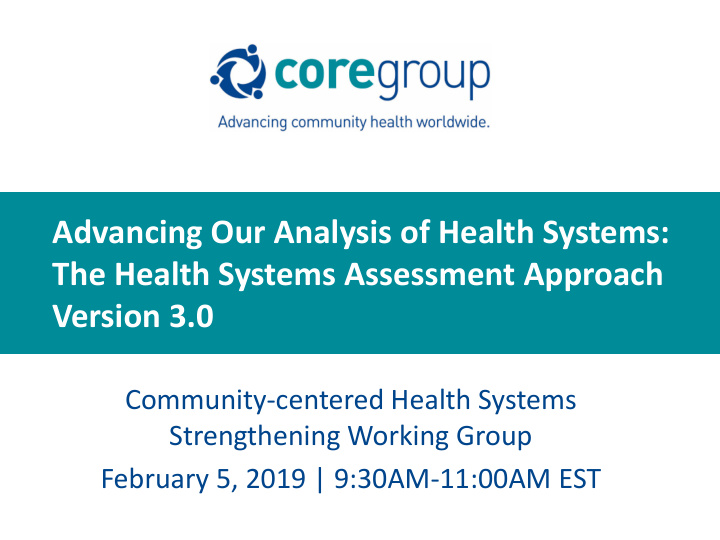



Advancing Our Analysis of Health Systems: The Health Systems Assessment Approach Version 3.0 Community-centered Health Systems Strengthening Working Group February 5, 2019 | 9:30AM-11:00AM EST
Presenter Catherine Connor has 33 years of experience in health, both domestic and international, working with governments, NGOs, the private sector, bilateral, and multilateral agencies in Africa, Latin America, and Asia. Since joining Abt Associates in 1999, she has managed and delivered technical assistance in health sector reform and system strengthening. Most recently she served as Deputy Director of USAID’s global Health Finance and Governance Project where she oversaw development of technical approaches and work plans, and implementation of health financing and governance activities including health insurance, health resource tracking and mobilization, and pay-for-performance. She has led assignments including a feasibility assessment of performance-based incentives in Mozambique, a health system assessment in Angola, and a regional health insurance workshop in Sub-Saharan Africa. Ms. Connor has an MBA with a concentration in Health Care Management from Boston University and is fluent in Portuguese.
What are some health system issues facing CORE Group members? People in the room note your responses Folks on the webinar - please use the poll Discussion time at the end
USAID’s Health Systems Assessment Approach What’s the Value Added?
Many tools and methods to inform decisions in the health sector – where does HSAA fit? Broad USAID’S Health Systems Broad scope Assessment Approach (HSAA) EQUIST Barrier Analysis Scope Community Health Committee SPECTRUM Assessment Toolkit From assessment to LiST Service Provision recommendations Assessment Focused Decision-Making Process
Assessment framework and methodology Analysis across all Performance functions indicators for each function Whole system and country context
System Weakness: Inadequate, unmotivated, unskilled staff; poor quality of care; stock-outs What to do? What to invest in? Disease/Service Health System Specific Response Response •Donors pay health workers • MoH able to advocate for more funds and able to contract salary or top-ups to deliver private providers focal services •Integrate training into medical • Intense off-site training on and nursing pre and in-service specific disease area education • Parallel donor procurement •E-procurement within MoF system system
HSAA: from assessment to recommendations HSAA validation workshop in Angola 2015
USAID’s Health Systems Assessment Approach Example from Angola
HSAA in Angola USAID MOH Requested HSAA Shaped the scope Funding Stakeholder workshop Reviewed and used Reviewed and used report for country report strategy HSAA Team 3 USAID project staff 1 local consultant
Synthesis of findings Health Health System Performance Indicators Subsectors Equity Access Efficiency Quality Sustainability Governance Power is concentrated in the executive branch and is very top-down, despite decentralization. The legal framework governing the health sector is relatively detailed and clear. Regulations are in place, but enforcement is weak. The MOH articulates sector plans that would address priority services and improve health system performance across all 5 indicators, but implementation is incomplete. Decisions about resource allocation and implementation are inconsistent with stated plans and priorities. There is little experience or mechanisms for accountability. Some provinces and municipalities working closely with private non-profit organizations on health issues. Financing Pattern of regressive Due to inadequate allocation of 40% of public funding of PHC, health financing public assets and health centers and allocated to tertiary External health posts charge user resources to an care; only 27% to financing is lower fees that are a primary and (8%) than other SSA financial barrier to elite minority, at Norms, protocols secondary care countries (20%). access. and training efforts the expense of Due to mineral are in progress. wealth, Angola Misallocation of larger population . theoretically has the resources (funds, Human However, lack of resources to sustain drugs, human Resources/ supplies, drugs and its health system, resources, Facilities supervision at PHC and even increase Estimated 60% of facilities) away level severely health financing. population is from highest Staff, facilities, and drugs weakens quality of without physical burdens of concentrated in hospital care, service delivery. access to any disease. not PHC that would most public facilities. benefit the 60% of the population below the poverty line. Drugs Essential drug Leakage of Severe stock-outs procurement essential drugs into of essential drugs dependent on informal market. donors.
HSAA in Angola: results 5 years later 1.Public spending on primary care rose 415% to capture 33% of total public health spending 2. Investments in PHC infrastructure guided by detailed ‘health maps” in 11 provinces 3. Budget management transitioning to district level
HSAA in Angola: feedback 1 year later “… your discussion on lack of accountability of local health services to their communities was instrumental in Mission decision to focus on increasing community capacity to advocate for and partner with local government in improved service delivery ” Feedback from Mission
What ’ s the Value Added – Summary • Comprehensive yet rapid • Focus on linkages across the six functions • System-wide view of strengths and weaknesses • Build consensus on recommendations and momentum to act
USAID’s Health Systems Assessment Approach How does the HSAA deliver? What’s inside?
The HSAA manual 2006 2018
Since 2006, HSAA has • Tutorial on health systems • Detailed steps to plan and conduct assessment – Define the purpose and scope – Engage local stakeholders – Organize the assessment team – Sample scopes of work, budget, schedule, report outline • Guidance on analysis, synthesis of findings, developing recommendations • 7 Technical Modules: Country context + 6 health system functions
Using the HSAA: Technical modules Country Context 1 7 3 2 5 4 6
Recommend
More recommend